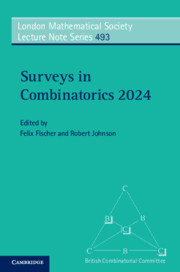Book contents
- Frontmatter
- Contents
- Preface
- Intersection Theory of Matroids: Variations on a Theme
- Erdős Covering Systems
- The Cluster Expansion in Combinatorics
- Sublinear Expanders and Their Applications
- Transversals in Latin Squares
- Finite Field Models in Arithmetic Combinatorics – Twenty Years On
- The Slice Rank Polynomial Method – A Survey a Few Years Later
- An Introduction to Transshipments Over Time
- Oriented Trees and Paths in Digraphs
- References
Sublinear Expanders and Their Applications
Published online by Cambridge University Press: 23 May 2024
- Frontmatter
- Contents
- Preface
- Intersection Theory of Matroids: Variations on a Theme
- Erdős Covering Systems
- The Cluster Expansion in Combinatorics
- Sublinear Expanders and Their Applications
- Transversals in Latin Squares
- Finite Field Models in Arithmetic Combinatorics – Twenty Years On
- The Slice Rank Polynomial Method – A Survey a Few Years Later
- An Introduction to Transshipments Over Time
- Oriented Trees and Paths in Digraphs
- References
Summary
In this survey we aim to give a comprehensive overview of results using sublinear expanders. The term sublinear expanders refers to a variety of definitions of expanders, which typically are defined to be graphs G such that every not-too-small and not-too-large set of vertices U has neighbourhood of size at least α|U|, where α is a function of n and |U|. This is in contrast with linear expanders, where α is typically a constant. We will briefly describe proof ideas of some of the results mentioned here, as well as related open problems.
Information
- Type
- Chapter
- Information
- Surveys in Combinatorics 2024 , pp. 89 - 130Publisher: Cambridge University PressPrint publication year: 2024
References
Accessibility standard: Unknown
Why this information is here
This section outlines the accessibility features of this content - including support for screen readers, full keyboard navigation and high-contrast display options. This may not be relevant for you.Accessibility Information
- 2
- Cited by
